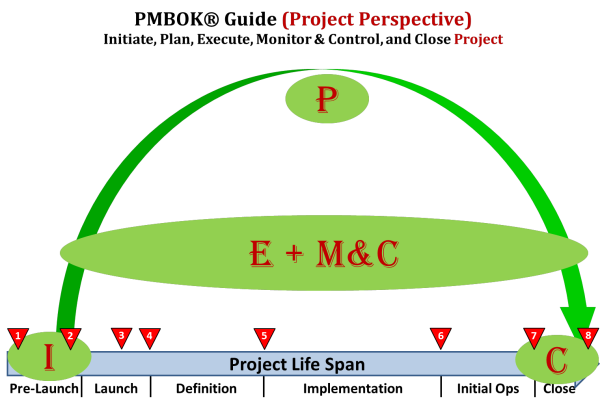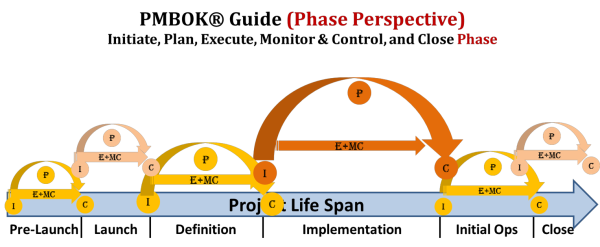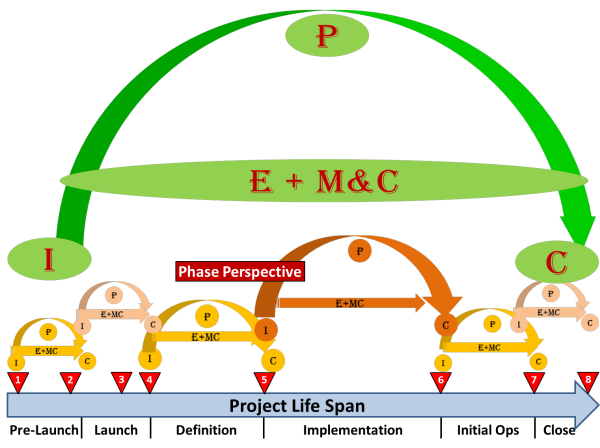This is sixth, and last, article in the series on Redefining Project Management. Each article can standalone but reading the full series would be most beneficial.
Earlier Articles in the Series
With the earlier articles, we provided an introduction to the series and why we need to redefine project management, we explained the differences between project life cycle and project life span,we discussed project phases, project stages and how we use each term,we addressed the last piece of the puzzle, the PMBOK® Guide Process Groups and we address the confusion between the PMBOK® Guide Process Groups and a typical project life span (project life cycle).
Today, we elaborate on the explanation and use graphical means to clarify the confusion between process groups and project life span, which is probably, the number one confusion in project management practice today.
Clearing the Doubts
In our effort to clarify the above, and the need for a project management methodology, we will map the PMBOK® Guide process groups to the stages of our CAM2P™ Model [1]. You can do the same for your own internal methodology or any other project management methodology that you use.
Mapping Process Groups to CAM2P™
As noted earlier, the PMBOK® Guide offers us five process groups called: Initiating, Planning, Executing, Monitoring and Controlling, and Closing … let us abbreviate them as: I, P, E, M&C, C. The PMBOK® Guide also provides us with an explanation that we need to Initiate, Plan, Execute, Monitor and Control, and Close the project … OR … phase … therefore, we use I, P, E, M&C, and C for the project as well as a phase.
Project Perspective
In the next graphic, Figure 1, we focus on the project and we show that we do indeed:
- Initiate every project; represented with the “I” in the green oval,
- Plan the project; represented with the “P” in the green oval and the green arch,
- Execute the project; represented with the “E” in the elongated green oval,
- Monitor and control the project; represented with the “M&C” in the elongated green oval, and
- Close the project; represented with the “C” in the green oval at the right side.
Phase Perspective
As the PMBOK® Guide clearly explains, we do also I, P, E, M&C, and C each project phase (or stage), which we show in Figure 2.
We know that some readers might be surprised, even shocked, at the detail shown in Figure 2. Here we need to remind you that from the beginning we said we will challenge the conventional wisdom and here we are doing it.
We have personally interviewed many project management professionals and even professionals conducting PMP classes that did not know the above and only know how to teach people to memorize the I, P, E, M&C, and C processes. We know that some might even feel insulted by my statement here and we are sorry if that is the case, but the fact is they may well have memorized the PMBOK® Guide contents yet still do not understand its basics.
Yes – we do initiate the pre-launch stage (pre-project – including feasibility study) and we plan for it and we execute it (doing the work of the pre-project is execution), and we do monitor and control and ultimately close the stage. We do the same for the next stage and the next and the next until we reach the end of the project life span.
Thus the process groups repeat, as many times as there are stages. Maybe not every single process applies every time and maybe in small/simple projects we do not need to do this if we can treat the whole project as a single phase. However, as projects grow in size or complexity, what we present here could mean the difference between project success and project failure.
Putting it All Together
In our last graphic, Figure 3, we present the CAM2P™ Model as we map the PMBOK Guide process groups at both the project level and the phase level.
The Impact/Threat
Some might argue that this whole series is discussing the obvious and not value added. For those who truly understand what we present, then obviously this paper will not add much to their knowledge and it would not be of benefit. However, this paper is not for this group of professionals, rather it is for those who do not fully understand the issues that we are discussing. In our humble opinion, there are many issues with this confusion or misunderstanding, which could lead to major problems in managing projects, hence the need for this series.
Unfortunately there are no studies that can demonstrate the impact of this misuse on projects. We can only speculate that on small/simple projects it might be safe to treat the project as a single stage project with no significant impact. However, we are willing to state a controversial opinion here – in most moderate, large, or complex projects — this confusion is leading to “challenged” if not “failed” projects. As we said, there are no studies specific to this point although there are numerous studies and literature that address project failure rates and state that a good percent of projects still fail. Failure has many causes and contributing factors; we are of the opinion and stress that lack of “proper” project management is a common cause and confusing the process groups constitutes a “lack of proper project management application”.
Conclusion
Confusing isn’t it?
It should not be – once we truly and correctly understand the PMBOK® Guide … What is important to recognize is that to effectively manage a project:
- You need a methodology that can be developed internally, or you can use something like SUKAD’s CAM2P™ project management methodology, or any other methodology
- You need the processes, such as what the PMBOK® Guide offers, and
- You need project management competence … such as is advocated by IPMA.
We suggest that the above three points are the core elements of project management maturity.
Our recommendation is that you read, read and read again, and compare what we have presented with what you currently practice. Then make some adjustments, at least on a trial basis, and see if that makes a difference to your project outcomes. There might be the normal learning curve but we know organizations are capable of judging whether what we propose adds value or not.
The last thing … attached is a CAM2P and Process Groups_Animated – Show that reflects today’s article. Take a few minutes to go over it.
With this article we close the series. Here we ask you to please let us know what you think. Where do you agree or not agree? How are you or your organization practicing project management today?
______________________________
[1] The CAM2P™ Model refers to the approach that we developed in SUKAD: The Customizable and Adaptable Methodology for Managing Projects™




Your way of explaining all in this paragraph is actually
pleasant, all be able to simply understand it, Thanks a lot.